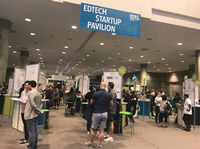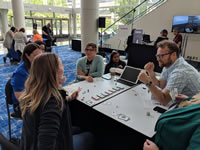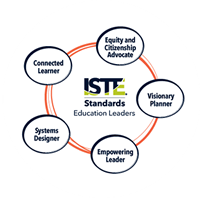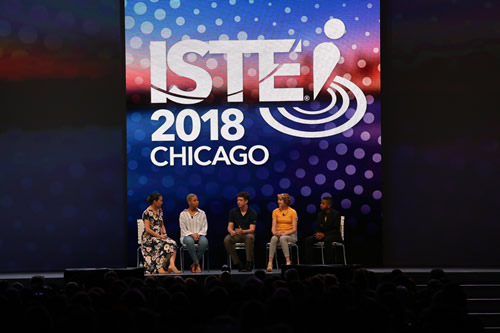ISTE18 for all students: The mindset & top 5 tools for inclusive best practice
One size fits none when it comes to learning! The keynotes, presenters, vendors, and attendees of #ISTE18 dialed in hard with a connected line of perspective, practical strategies, and game-changing edtech tools to push all students full STEAM ahead into the new school year.
All means all
As teachers, our number-one mission and passion is to reach all the students we teach in a way that is equitable, meaningful, and impactful. That said, we also know that how each student learns is unique to each individual student. We also know that the way they show what they know is equally unique. In order to capture the outcomes we seek, we must embrace an inclusive and flexible mindset where student voice and student choice are driving the bus forward in their journey of learning.
Flexibility
At #ISTE18, keynote speaker Dr. David Eagleman spoke about the need for emotional engagement (some may think of this as “buy in”) and teaching “best skills” to help kids be cognitively flexible and develop a toolbox for innovation. What better way to do that than through modeling what flexibility is, looks like, and feels like?
Christopher Bugaj, Kendra Grant, and Luis Perez echoed exactly this perspective on Wednesday morning as they “walked the walk” in their session on the many ways to frontload multi-modality voice and choice to all students. The panel of presenters challenged everyone to ask themselves two important questions whenever designing instruction and learning opportunities for all students: “Is it Accessible?” and “Is it Awesome?”
With these two burning questions as our guiding force and the wide array of innovative edtech tools available to use, we should rarely, if ever, miss the mark.
Filling the toolbox
Here are five must-try tools to check out as you reflect on #ISTE18 and how you will use what you learned, claim your flexible mindset, and gear up for inclusive best practices that fit your classroom, school, or district.
1. G Suite For Education: A free suite of tools to help students and teachers communicate and collaborate in a seamless, secure manner across devices. In addition, specialized apps and extensions are available through the Chrome store, including Read&Write for Google Chrome, Screencastify, Move It, Vysor, and Grammarly, to name a few. Definitely worth checking out!
2. Microsoft Learning Tools: Free tools to improve reading and writing skills for all ages and abilities. Specific learning tools include enhanced dictation, focus mode, immersive reading, reading speed, and syllabification. Learning tools are available for use across platforms and devices.
3. Flipgrid: A video discussion platform where student voice is amplified and heard like never before. The Flipgrid experience helps grow social learning skills as students record, watch, discuss, react, and respond to their experiences and perspectives with each other. Free to all educators and accessible to students, parents, or audience of choice with link and password.
4. PlayPosit: An online learning platform used to develop and share interactive video lessons. PlayPosit supports a number of video sources and allows teachers to pause videos, insert questions, and promote differentiated delivery of content as well as deeper critical thinking and reflection opportunities. Free to all educators and students.
5. Kahoot: A game-based learning platform used to administer study review, quizzes, discussions, or surveys. A whole class can play at once in real time. Multiple-choice questions are shared on a screen. Students respond to the questions via computer, smartphone, or tablet. Free to all educators and students.
One to watch: ClassAlexa
—Kimberly Zajac MA CCC-SLP/A; C/NDT
ISTE18 Voice and Choice
Chicago–the home of gangsters, Chicago-style pizza, and world-famous Bean aka the Cloud Gate–had the honor of hosting ISTE 2018. More than 20,000 people descended upon the McCormick Place West Convention Center to experience the “Epicenter of EdTech.”
The BYOD workshops and hour-long sessions had the usual high draw, with attendees waiting in lines and excited to hear about how edtech is transforming student engagement, collaboration, and creativity. However, what I noticed at this conference the most was the focus on student, teacher, and education leaders’ voice and choice.
The first events that focused on voice and choice were the 14 Playgrounds that took place over the four-day event. Presentations ranged from makerspaces to digital storytelling to edtech coaches.
Everywhere you looked in the Skyline ballroom, hands-on presentations reflected the trends going on in classrooms across the world. The Ready, Player 101 playground focused on how AR, VR, and MR create connections for students and teachers around these trending technologies in classroom. The Google for Education Playground held seven sessions on Tuesday during which presenters focused on creating, exploring, discovering, and designing applications that can empower our students and teachers.
While the student 3D poster presentations are going the way of the VCR, they are not going away as opportunities for coaches, library media specialists, and classroom teachers to showcase what is going on in their schools and classrooms. The 400 poster sessions that lined the walls on Skyline Ballroom were extremely popular.
Conference attendees lined up to have one-to-one conversations with the presenters around coding, accessibility, digital citizenship, and personalized learning.
If we ever needed a reminder as to why we are all in the education business, all you had to do was look around the McCormick Place Conference Center and see the amount of student presenters at this conference. The Global Student Voice Festival’s main goal of student voice, agency, and empathy characterized the mindset of our students from ages 5-18 that they can make a difference now! The other student-focused event took place on the vendor floor throughout the week. The ISTE Hackathon brought students from all over the world together for two days to “identify, research and solve real- world problems.” I had the opportunity to check out this inspirational event and left knowing that if I can empower my teachers and students in the same way, we will be building a better world for future generations.

The last voice I want to highlight took place at the Startup Pavilion. This pavilion provided opportunities for startup companies to showcase what they believe are new trends in edtech.
- LiftEd supports special education teachers through an online platform that monitors, tracks, and provides live support for students on IEP and 504 plans.
- Circkled In, a free student portfolio platform that supports students in their pursuit of college admission, believes in putting kids at the center of the circle.
- While many coding programs use the block method, Bitbots is a text-based product that uses programming language such as java and python and allows students to be creative and challenged.
I left this conference with renewed energy, strategies, resources, and connections that will excite my teachers and students in the upcoming school year. See you in Philadelphia 2019!
–Eileen Belastock
A letter to #ISTE18 and #NOTATISTE
To whom it may concern:
#Ditchpanel was trending at ISTE 2018. 400 people grabbed seats to hear seven educators speak openly and honestly about the trials and tribulations of creating classroom environments that follow moderator Matt Miller’s DITCH acronym (Different, Innovative, Tech-Laden, Creative, or Hands On). It was like sitting in our living room and having a fireside chat with passionate educators who are in the trenches.
This panel was not about ditching the textbook but rather changing the way you teach. I was lucky enough to be part of this amazing panel with people I had known on Twitter for years and met face to face at 7 AM that morning for a Ditch Family breakfast. This is the power of Twitter. It brings people together. We all use technology to amplify student voices and think about what we can do now that we couldn’t do before?”
Representing classroom teachers and administrators, the panelists inspired audience members to revolutionize student learning. We discussed how the DITCH mindset has changed us and what DITCH element was most important to us and why, engaging those in the audience and #NOTATISTE to answer too through Twitter. Lessons were shared that educators could use in their classrooms the next day. I reminded people to beg, borrow, and steal lessons. We build a culture of sharing. It is how we grow.
Each panelist showed his or her vulnerabilities, discussing when things blew up in his or her face, and how we dealt with pushback. Closing the classroom door is no longer an option. Let the innovation flow! We reminded the audience that it is powerful if things do not work out as planned. Reflection is key when things don’t go well. Model for students and colleagues and let them know it’s ok when things don’t go right. The conversation culminated with a discussion on favorite tools, procedures, and routines.
That night I ran into someone who shared with me that the panel presentation changed her life. She told me she now felt she could take more risks and was reminded of why she got into this profession. I wanted to bring a piece of advice from some of our panelists to you! This is what happens when a group of strangers meet on Twitter and start getting real.
Lessons from #ditchpanel #iste18
“The number-one thing is to get feedback from the students. Kids need freedom to make choices and explore. I had students use Flipgrid to record an interview with a parent about how they use percentages in real life. Students see relevancy and the parents see how the tool is used.“ –Sean Fahey
“At back-to-school night parents need to come with their child’s Google log in. Just like the kids, they go into Google classroom and open the presentation for the evening. They watch a Flipgrid of their child sharing his or her hopes and dreams and then create one for their child. I teach the parents and make them part of my classroom.” –Rayna Freedman
“When thinking about which DITCH is important to me, I just say pick one. I had fifth-grade buddies with my class for Global Read Aloud. Through Skype, Google Sites, Flipgrid, and Padlet we held book discussions for Long Walk to Water. We made BookSnaps with our buddies, and I had a student who did not love to read but changed his mindset just to make his BookSnap.” –Krista Harmsworth
“It’s not about the app. It’s about the connection the app provides! I want to peek into the minds of my students. Use technology to connect with a student’s heart.” –Tara Martin
If you were one of the 400 joining us for an hour or were not able to attend, we are just a tweet away to help you with ideas to reach your students, teachers, and administrators. That was the biggest message people left the panel with. Technology allows us to build relationships and reach into the hearts of others. Thank you #ISTE18 for having us!
XOXO
–Rayna Freedman (& The Ditchbook Crew)
6 from 27: Reflections on ISTE18
Through various social media platforms, people have already revealed much about this year’s ISTE Conference, though navigating through the abundance of contributions is quite daunting. Therefore, given that ISTE ’18 officially wrapped on June 27, I asked these six questions to 27 folks who attended and/or tweeted using the hashtag #ISTE18.
Here’s some* of what they had to say:
1. What was/were the best session/s you attended?
The Keynotes, ISTE Ignite Sessions, Playgrounds, and Poster Sessions were recognized, as well as the following:
Digital Portfolios & Partnerships
#OneStoryForward: Changing Communities One Story at a Time
Beef Up Critical Thinking: Socratic Seminar and Tech
Saving Democracy: Educator’s Survival Guide to Fake News Across the Curriculum
Bright Ideas for E-Learning Design
2. What session/s do you wish you could/would have attended?
The ISTE Ignite Sessions, Playgrounds, Apple Sessions, and Poster Sessions were on many lists, as were:
The Stupidest Trends in EdTech (And Why They’re Actually Quite Awesome)
Ramping Up Revision: Teaching Targeted Peer Review
Drawing As a Thinking Process – It’s More Than Sketchnoting
Let’s MAKE A Deal!
Top Tech Tips for Busy Administrators
3. What were the memorable social events you attended?
Immerse Yourself in Literacy
EdTech Karaoke
A Night at The Field Museum
ISTE Literacy PLN & Actively Learn Social Event
Ed Tech Poetry Slam
Classcraft’s Questathon
Flipgrid’s Speakeasy
ISTE Midwest States Reception
Discovery’s event @ Spin
Canvas’ event on the River Walk
Facebook Social Mixer
4. What are some memorable new tools/products/ resources you learned about?
Actively Learn
Adobe Spark
Audioforslides.com
Badgr
Bloomz
Bloxels Edu
Bretford’s latest iteration of its TechGuard Connect®
Canvas LMS
CK 12 Foundation
Cross Braining
Crio
Cultivate World Literacy
Dynamic Learning Project
Future Ready Leadership
Google Science Journal
ISTE EdTech Advisor
Jing Screen Captures
MATLAB Coding Robots
Otter Voice Notes
Pi-Top Computing
21 Things Project
VEX coding platform
zSpace AR/VR Laptop
5. If you attend ISTE 2019, what will you do differently?
“Rather than be on a panel, I’m going to organize a panel of educators whose voices I want to amplify.” –@pronovost
“I would like to attend more content-specific sessions. Science sessions that were not posters were few and far between.” –@liz1544
“Try to limit commitments and do fewer things more deeply.” –@andrewtwallace
“Perhaps I’d focus on less of the sessions and do more informal, intentional connection in the hallway/charging stations.” –@adewitt2
“Get to sessions earlier. I was blocked out of too many because I didn’t show up early enough.” –@MrKennyEdTech
“Force work to send more of my team!” –@Mathletics_MW
6. Anything else you would like to add?
“ISTE is the one event that opened my eyes to the breadth of education in the United States and overseas. I am continuously astonished by the growing number of amazing educators in one physical space at the same time. The network of professionals that I have created from this conference keeps me encouraged, optimistic, and hopeful about the future of education in America.” –@leontynesjr
“I had the honor of working on both the new ISTE Certification and ISTE U offerings, which launched at the conference to excitement and interest. Cannot wait to see the impact and reach of these projects in the coming year!” –@NancyeBlackEdu
“As educators, we have a consistent uphill battle in our profession; however, together we can make great strides forward.” –@andycinek
“Would like to see less “bells and whistles” and more on building student capacity. Just because students can do something doesn’t mean they’re getting something out of it (learning-wise).” –@mrtwhalen
“The quality of educators and their energy was inspiring. It’s great to be in contact with so many people with such a passion for education.” –@c_johnson007
“Was the first ISTE in a new role and company but 11th overall. Always a great time to see friends and acquaintances and catch up. One of my favorite weeks every year.”
–@RyanKeag12
“Impromptu conversations with educators were a priceless addition to my conference experience.” –@chemichall
Beyond the above information, participants revealed that they made several new relationships. The total number of new relationships these 27 people made equaled more than 1,000! Expand that number and follow the #EduAllStars who shared their responses:
@AggiesalterITS
@MrsRubinoELA
@edtechcaitlin
@andycinek
@Mathletics_MW
@jenwagner
@c_johnson007
@MrKennyEdTech
@wasse
@adewitt2
@pronovost
@KristinCHarr
@NancyeBlackEdu
@lauranylen
@teachingfactor
@henrythiele
@RyanKeag12
@MrAguina
@chemichall
@mrtwhalen
@andrewtwallace
@synergyined
@liz1544
@ELAPizzoStyle
@NeelDesaiBA
@leontynesjr
@MrSteinbergHHS
*The responses were provided by those who took my survey; please forgive any errors/inaccuracies.
Interested in the complete outcomes of the survey? Message me!
Email: kellymhealey@gmail.com
Twitter: @kwildehealey
LinkedIn: Kelly Wilde Healey
–Kelly Wilde Healey
ISTE18 STEM PLN presents the future: powered by STEAM
The STEM PLN Playground offers an opportunity for educators to participate in hands-on play with classic and new forms of research-based tools, to share ideas and experiences in an informal setting, to see examples of student work, and to leave inspired to try new things—all related to STEAM. The Playground also provides an outlet for STEM educators and sponsors to share their lessons and materials with like-minded enthusiasts.
By the end of the multi-hour session, participants walked away with multiple lesson ideas to easily and immediately implement into their own setting.
Participants also benefitted by being able to contact presenters and access resources through the Playground “Digital Tote.”

As one of the newer members of ISTE’s STEM PLN Leadership Team and one of the Playground’s organizers, I had an inkling of what to expect but found myself pleasantly surprised by the genuine, untamed enthusiasm of all of our presenters which translated into amazing, hands-on learning opportunities for our participants.
From “Catch the Hyperdoc Fever” by MassCUE’s Rayna Freedman, “The Cross Age Student Dream Team for Computer Coding” by Amanda Hough, “Steminizing the World” by Rachel Sheffield,” “Track a Satellite” by Bonnie Thurber, “Books Come Alive: Augmented Reality Book Trailers” by Jolandra White and Choleia Smith Ray, to “Novel Engineering: Bringing Literature to Life with STEM” by Tina Lauer, there truly was something for everyone to inspire cross disciplinary, STEM/STEAM innovation and creativity in classrooms, schools, districts, and communities nationwide.
Here are some of the thoughts I’ve been percolating that summarize my experience at the STEM Playground at ISTE this year.
Somewhere between meeting Johannes Strobel, professor in the School of Information Science & Learning Technologies, University of Missouri, who was honored with this year’s ISTE STEM Excellence Award, being offered coffee and a Steminist t-shirt by Rachel Sheffield, and shooting the breeze with brilliant minds from NASA, I was reminded why I chose this business of education: My playful, childlike, endlessly curious self needs to be continuously surrounded by new ideas and new people. It seems to me that all ISTE conference attendees, presenters, and organizers fall under the category of “lifelong learners.”
Lifelong learning is defined as the ongoing, voluntary, and self-motivated pursuit of knowledge for either personal or professional reasons. I found it all by being involved with ISTE’s STEM Playground and STEM leadership team.
Beyond the new learning concepts, new professional connections, and sheer buzz of conference adrenaline that one experiences at an event such as ISTE’s STEM Playground, the hands-on aspect grounds the experience into tangible, practical strategies for applying what is learned in one’s own educational setting.
Most importantly, what you learn in a Playground setting is not just practical, replicable, and interesting; this form of learning is, to put it in plain and simple terminology, just pure fun!
—Cathy Collins, Ed.D.
CoSN CTO Forum at ISTE 2018
On Tuesday, June 26th at ISTE 2018, CoSN held one of its two yearly CTO Forums. The focus, “Taking Action: Closing The Digital Divide,” brought CTOs and CIOs from around the world to discuss their solutions and struggles on the topic of digital equity. Richard Culatta, ISTE chief executive officer, said that there were more than 1,000 CTOs and CIOs in attendance at this year’s conference. What better location for this important discussion?
The forum was moderated by Keith Krueger, CoSN CEO, along with a panel of educational leaders that have found real solutions to this digital divide. These educational leaders included Diane Doersch, CTO of Green Bay Area (WI) Public School District, Marlo Gaddis, interim CTO, Wake County (NC) Public School System, Andrew Moore, CIO of Boulder Valley (CO) School District, and Scott Smith, assistant superintendent, Mooresville (NC) Graded School District.
As educational leaders, we struggle with connecting with our colleagues and this roundtable-style forum was the perfect venue for deep discussions around the topic of digital equity.
Earlier in the week, ISTE revealed the long-awaited revision of its 2009 ISTE Standards for Administrators. Because “administrator” was not transferable in other countries, the standards were changed to education leaders to reflect the changing roles we all play in this technology-rich educational environment.

This CTO forum focused on Standard 1 Equity and Citizenship Advocate, and the discussions at the tables focused on the fact that access is the crucial component. Access is not just about ensuring that students have access to devices; education leaders are putting their priorities on student access to resources, supports, content, and curriculum inclusion. Also, they are taking a hard look at teacher instructional expertise and evaluating the digital equity that can look different in every classroom.
Many of the education leaders in the room could relate to how our slow rollout plans for our 1:1 programs quickly turned into rapid rollout plans. We were faced with classrooms and students with the technology tools but not the educational tools necessary to incorporate into classroom practice.
So how do we support and develop programming that ensures that we have skilled teachers in classroom who use technology actively in classrooms? Dr. K. May-Vollmar summarized it best when she said, “No longer will teachers be trained in technology separate from curriculum training. Curriculum experts, tech experts, and differentiation experts work in teams to train site-level coaches across the district.” This change in mindset happens when school districts give their educators voice and choice in the delivery method and focus when it comes to their own professional development.
Whether or not a school district has a high free and reduced lunch student population, access to out-of-school connectivity is a challenge for all CTOs and CIOs. Online learning is no longer an option for school districts when it comes to ensuring that our students collaborate, think critically, and be creative. Devices in students’ hands does not mean access to technology is in student’s hands. Solutions to out-of-school connectivity for students ranged from mobile hotspots to wifi on buses to districts building their own LTE networks. As connectivity is not a school issue but a community issue, many districts are partnering with local business and universities for funding and support.
Embedded and systemwide digital citizenship curriculum is a top priority for districts. Identifying biases and incorporating social and emotional learning experiences are the first steps to ensuring positive social change. Using web resources such as Interland by Google and Common Sense Media, school districts are developing sustainable programming to ensure that students have the skills to evaluate information that they read, see, and hear. Modeling digital responsibility by adopting responsible use policies, these education leaders are driving positive school culture.
The last strand for the ISTE Standard One for Education Leaders focuses on the safe, ethical, and legal use of technology. Kyle Hamstra stated it best when he quoted Shaelyn Farnsworth from her ISTE Ignite session: “Censorship is not the answer—empowerment is!”
Training our educators on the implications of COPPA, FERPA, and CIPA ensures that school districts are guaranteeing student safety and privacy. One of the concerns of education leaders is the easy access to third-party apps that can potential cause students harm. Many of the school districts represented at this forum are taking measures to vent and approve educational apps. Involving parents, teachers, students, and building administrators are key to ensuring appropriate use of digital materials.
Thank you CoSN and ISTE for providing this collaborative experience as we bring the resources and connections gathered during this invaluable CTO Forum back to our school districts.
—Eileen Belastock
- 4 ways to encourage play in education - April 25, 2024
- CoSN IT Leader Spotlight: Lisa Higgins - April 25, 2024
- It’s time to pay student teachers - April 25, 2024

